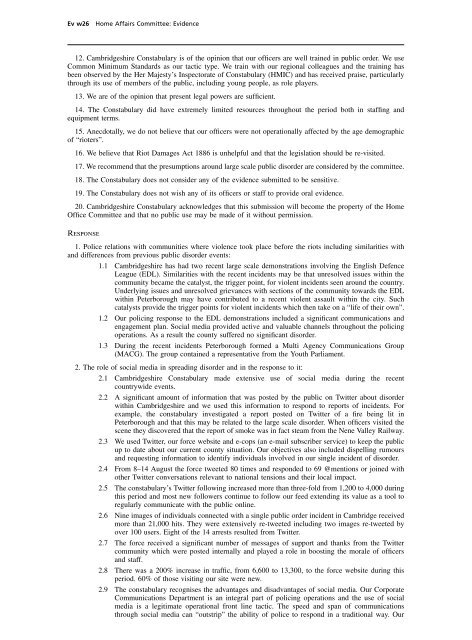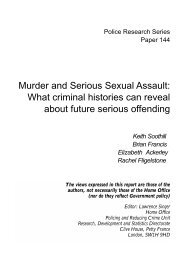Policing Large Scale Disorder: Lessons from the disturbances of ...
Policing Large Scale Disorder: Lessons from the disturbances of ...
Policing Large Scale Disorder: Lessons from the disturbances of ...
Create successful ePaper yourself
Turn your PDF publications into a flip-book with our unique Google optimized e-Paper software.
Ev w26 Home Affairs Committee: Evidence<br />
12. Cambridgeshire Constabulary is <strong>of</strong> <strong>the</strong> opinion that our <strong>of</strong>ficers are well trained in public order. We use<br />
Common Minimum Standards as our tactic type. We train with our regional colleagues and <strong>the</strong> training has<br />
been observed by <strong>the</strong> Her Majesty’s Inspectorate <strong>of</strong> Constabulary (HMIC) and has received praise, particularly<br />
through its use <strong>of</strong> members <strong>of</strong> <strong>the</strong> public, including young people, as role players.<br />
13. We are <strong>of</strong> <strong>the</strong> opinion that present legal powers are sufficient.<br />
14. The Constabulary did have extremely limited resources throughout <strong>the</strong> period both in staffing and<br />
equipment terms.<br />
15. Anecdotally, we do not believe that our <strong>of</strong>ficers were not operationally affected by <strong>the</strong> age demographic<br />
<strong>of</strong> “rioters”.<br />
16. We believe that Riot Damages Act 1886 is unhelpful and that <strong>the</strong> legislation should be re-visited.<br />
17. We recommend that <strong>the</strong> presumptions around large scale public disorder are considered by <strong>the</strong> committee.<br />
18. The Constabulary does not consider any <strong>of</strong> <strong>the</strong> evidence submitted to be sensitive.<br />
19. The Constabulary does not wish any <strong>of</strong> its <strong>of</strong>ficers or staff to provide oral evidence.<br />
20. Cambridgeshire Constabulary acknowledges that this submission will become <strong>the</strong> property <strong>of</strong> <strong>the</strong> Home<br />
Office Committee and that no public use may be made <strong>of</strong> it without permission.<br />
Response<br />
1. Police relations with communities where violence took place before <strong>the</strong> riots including similarities with<br />
and differences <strong>from</strong> previous public disorder events:<br />
1.1 Cambridgeshire has had two recent large scale demonstrations involving <strong>the</strong> English Defence<br />
League (EDL). Similarities with <strong>the</strong> recent incidents may be that unresolved issues within <strong>the</strong><br />
community became <strong>the</strong> catalyst, <strong>the</strong> trigger point, for violent incidents seen around <strong>the</strong> country.<br />
Underlying issues and unresolved grievances with sections <strong>of</strong> <strong>the</strong> community towards <strong>the</strong> EDL<br />
within Peterborough may have contributed to a recent violent assault within <strong>the</strong> city. Such<br />
catalysts provide <strong>the</strong> trigger points for violent incidents which <strong>the</strong>n take on a “life <strong>of</strong> <strong>the</strong>ir own”.<br />
1.2 Our policing response to <strong>the</strong> EDL demonstrations included a significant communications and<br />
engagement plan. Social media provided active and valuable channels throughout <strong>the</strong> policing<br />
operations. As a result <strong>the</strong> county suffered no significant disorder.<br />
1.3 During <strong>the</strong> recent incidents Peterborough formed a Multi Agency Communications Group<br />
(MACG). The group contained a representative <strong>from</strong> <strong>the</strong> Youth Parliament.<br />
2. The role <strong>of</strong> social media in spreading disorder and in <strong>the</strong> response to it:<br />
2.1 Cambridgeshire Constabulary made extensive use <strong>of</strong> social media during <strong>the</strong> recent<br />
countrywide events.<br />
2.2 A significant amount <strong>of</strong> information that was posted by <strong>the</strong> public on Twitter about disorder<br />
within Cambridgeshire and we used this information to respond to reports <strong>of</strong> incidents. For<br />
example, <strong>the</strong> constabulary investigated a report posted on Twitter <strong>of</strong> a fire being lit in<br />
Peterborough and that this may be related to <strong>the</strong> large scale disorder. When <strong>of</strong>ficers visited <strong>the</strong><br />
scene <strong>the</strong>y discovered that <strong>the</strong> report <strong>of</strong> smoke was in fact steam <strong>from</strong> <strong>the</strong> Nene Valley Railway.<br />
2.3 We used Twitter, our force website and e-cops (an e-mail subscriber service) to keep <strong>the</strong> public<br />
up to date about our current county situation. Our objectives also included dispelling rumours<br />
and requesting information to identify individuals involved in our single incident <strong>of</strong> disorder.<br />
2.4 From 8–14 August <strong>the</strong> force tweeted 80 times and responded to 69 @mentions or joined with<br />
o<strong>the</strong>r Twitter conversations relevant to national tensions and <strong>the</strong>ir local impact.<br />
2.5 The constabulary’s Twitter following increased more than three-fold <strong>from</strong> 1,200 to 4,000 during<br />
this period and most new followers continue to follow our feed extending its value as a tool to<br />
regularly communicate with <strong>the</strong> public online.<br />
2.6 Nine images <strong>of</strong> individuals connected with a single public order incident in Cambridge received<br />
more than 21,000 hits. They were extensively re-tweeted including two images re-tweeted by<br />
over 100 users. Eight <strong>of</strong> <strong>the</strong> 14 arrests resulted <strong>from</strong> Twitter.<br />
2.7 The force received a significant number <strong>of</strong> messages <strong>of</strong> support and thanks <strong>from</strong> <strong>the</strong> Twitter<br />
community which were posted internally and played a role in boosting <strong>the</strong> morale <strong>of</strong> <strong>of</strong>ficers<br />
and staff.<br />
2.8 There was a 200% increase in traffic, <strong>from</strong> 6,600 to 13,300, to <strong>the</strong> force website during this<br />
period. 60% <strong>of</strong> those visiting our site were new.<br />
2.9 The constabulary recognises <strong>the</strong> advantages and disadvantages <strong>of</strong> social media. Our Corporate<br />
Communications Department is an integral part <strong>of</strong> policing operations and <strong>the</strong> use <strong>of</strong> social<br />
media is a legitimate operational front line tactic. The speed and span <strong>of</strong> communications<br />
through social media can “outstrip” <strong>the</strong> ability <strong>of</strong> police to respond in a traditional way. Our
















